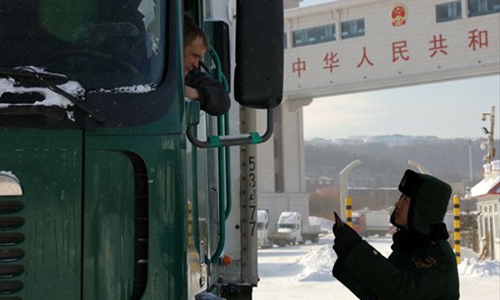SOURCE / MARKETS
China, Russia expect a boost in bilateral trade volume in 2021

A security officer checks a truck at the border checkpoint in Suifenhe in Northeast China's Heilongjiang Province.Photo: IC
Trade and investment between China and Russia remain stable and will gain new impetus in the coming year after the coronavirus pandemic is curbed, Russian envoys said.China remains to be Russia's largest trading partner, accounting for 17 percent of Russia's foreign trade in the first three quarters of 2020, Zhang Hanhui, Chinese ambassador to Russia, said in a recent interview with the Sputnik news agency. Russia's agricultural exports to China rose by 15.8 percent, and China's non-financial direct investment in Russia grew by 7.4 percent, Zhang said.
"This year, we have significantly increased our agricultural cooperation, reflected by rising Russian agricultural exports to China, and I expect the trend will continue next year," said Russian ambassador to China Andrey Denisov at the annual press conference held by the Russian Embassy in Beijing on Tuesday. He noted that the trade volume between the two nations has been sustained despite the pandemic.
Among the growing sectors, the soybean trade is considered one of the biggest potential markets for growth. China's domestic soybean market is 100 million tons per year, and Russia's annual export to China is one million tons, equivalent to just one percent of China's demand.
Although some agricultural products and food exports to China are not particularly large, they have played a stabilizing role for the Chinese market, the ambassador said.
"It is most promising in expanding our agricultural investment cooperation. We are able to build large agricultural complexes in Russia, attract Chinese investors and export our produce such as soybeans to China," Denisov said, noting it will not aggravate competition with US exports to China.
Previously, officials from China and Russia said they would strive for positive growth in bilateral trade this year, but due to the logistic hurdles caused by the virus, in the first 11 months of this year, bilateral trade fell by 3 percent.
"Our road transport capacity has declined. Now the drivers and loaders from the Russian side are facing stricter virus control measures, so the number of transport trucks is reduced," Denisov said.
Although the passenger flow between China and Russia has basically stopped, freight transport, including rail transport, is continuing with the efforts on both sides of the border, experts said.
"Among the positive growth, soybean exports to China are particularly encouraging with the price of soybeans rising, driven by market demand," Song Kui, president of the Contemporary China-Russia Regional Economy Research Institute, told the Global Times on Tuesday, noting that customs are promoting trade through digital declaration and that authorities are introducing direct settlement of trade with Chinese yuan and Russian ruble.
The growing level of trade facilitation between China, Russia and Mongolia, has further strengthened the construction of railway links and other transportation infrastructure over recent years, with more progress made in railway tunnel construction, according to a report by the National Development and Reform Commission on Tuesday. The joint works also created improved conditions for the three countries to further expand the scale of the energy resources sharing, such as coal trade.
Given the magnitude of China's market and the resilience of bilateral trade, Denisov predicated that next year, the trade volume will maintain or even surpass the level set in 2020 after the pandemic is contained.
"I have no doubt that next year will see the implementation of major investment and cooperation projects, including energy, natural gas and nuclear energy between our two countries," said the ambassador.

